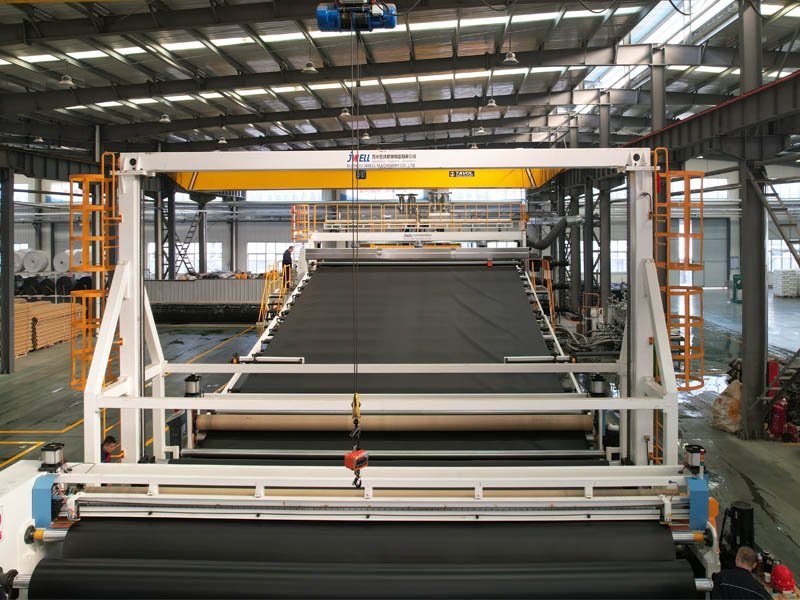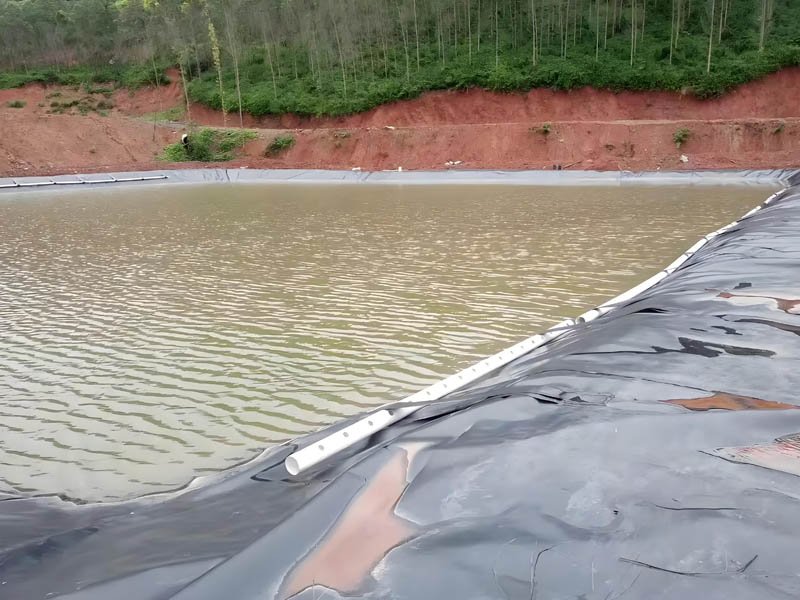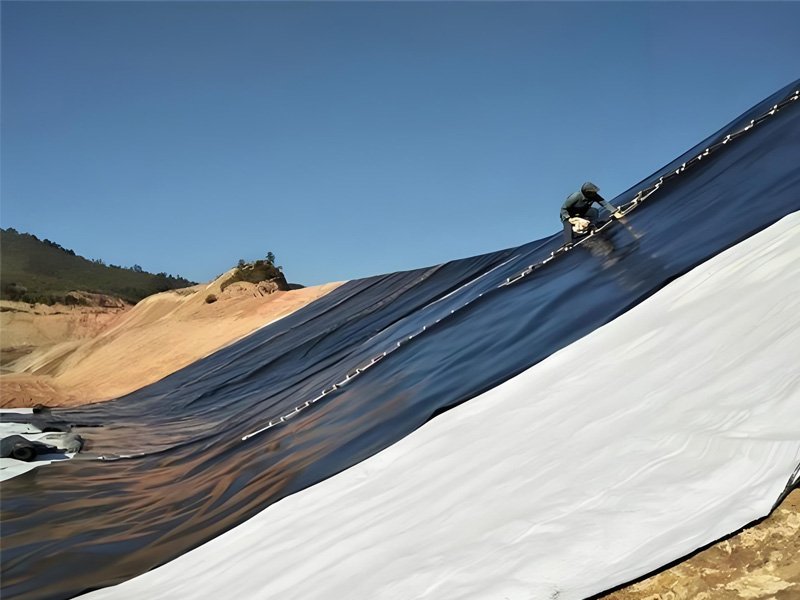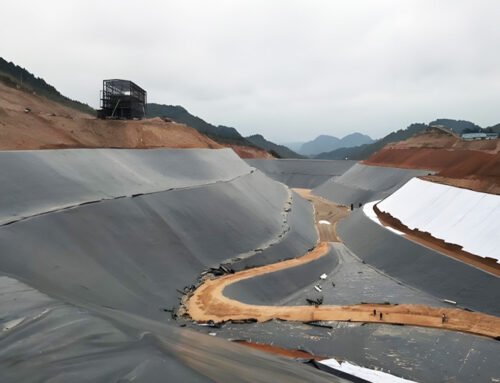HDPE Pond Liner Sheet, also known as a High-Density Polyethylene Geomembrane, is a type of geomembrane made from high-quality high-density polyethylene (HDPE). It is manufactured using a special formulation of virgin polyethylene resin, carbon black, antioxidants, anti-aging agents, and UV resistance components. These additives enhance the liner’s resistance to UV radiation, making it suitable for exposed conditions.
BPM Geosynthetics HDPE Geomembranes are known for their durability and ability to withstand higher temperatures, extending their service life. They offer a cost-effective solution for containment applications due to their low cost, excellent chemical resistance, and weathering properties.
1. What Is The Function Of HDPE Pond Liner Sheet?
The HDPE pond liner sheet serves several critical functions in the construction and maintenance of water containment structures such as ponds, reservoirs, and other similar facilities. Here are some of its primary functions:
1.1 Waterproof Barrier:
The most fundamental function of an HDPE pond liner is to create a waterproof barrier at the bottom and sides of the pond. This prevents water from seeping into the surrounding soil, which could lead to water loss, erosion, or groundwater contamination.
1.2 Containment:
By acting as a containment system, the HDPE liner ensures that water remains within the designated boundaries of the pond. This helps maintain the intended shape, volume, and functionality of the water body.
1.3 Chemical Resistance:
HDPE is highly resistant to a wide range of chemicals, including acids, bases, and salts. This makes it suitable for use in various types of water bodies, whether they contain treated water or have varying pH levels.
1.4 Flexibility and Durability:
HDPE liners are both flexible and durable, allowing them to conform to the contours of the pond’s bottom and sides. They can withstand temperature fluctuations, UV radiation, and physical stresses without tearing or degrading quickly.
1.5 Environmental Protection:
By preventing water leakage, HDPE liners help protect the surrounding environment from pollution and contamination. They also reduce the risk of invasive species entering or leaving the pond, thereby preserving local ecosystems.
1.6 Cost-Effectiveness:
Compared to other materials like concrete or specialized coatings, HDPE liners are generally more cost-effective due to their long lifespan, ease of installation, and low maintenance requirements.
1.7 Ease of Installation:
HDPE sheets are typically supplied in large rolls or panels, making them relatively easy to install over prepared surfaces. They can be heat-welded or glued together to cover larger areas seamlessly.


2. What Projects Are HDPE Pond Liner Sheet Suitable For?
HDPE pond liner sheets are highly versatile and suitable for a variety of industrial projects where water containment, environmental protection, and durability are essential. Here are some key industrial projects where HDPE liners excel:
2.1 Industrial Wastewater Treatment Plants:
In industrial settings, HDPE liners are ideal for lining wastewater treatment lagoons, tanks, and other containment structures. Their chemical resistance makes them suitable for handling various types of industrial wastewater, preventing leakage and protecting the environment.
2.2 Mining Operations:
For mining companies, HDPE liners are used to line tailings ponds, settling ponds, and other storage areas. Their durability and resistance to harsh chemicals ensure that they can withstand the demanding conditions of mining operations, ensuring compliance with environmental regulations.
2.3 Solar Evaporation Ponds:
In the production of solar salt and other evaporation processes, HDPE liners are used to line large ponds. They prevent water loss through evaporation and seepage, enhancing the efficiency of the evaporation process.
2.4 Oil and Gas Industry:
In the oil and gas sector, HDPE liners are used to line secondary containment areas, spill berms, and pits. Their ability to resist oils, chemicals, and extreme temperatures makes them suitable for containing spills and preventing environmental contamination.
2.5 Agricultural Reservoirs and Irrigation Ponds:
For agricultural operations, HDPE liners are ideal for constructing reservoirs and irrigation ponds. They prevent water loss due to seepage, ensuring efficient water management and conservation, which is crucial for maintaining adequate water supply for crops and livestock.
2.6 Construction Site Dewatering:
On construction sites, HDPE liners can be used in dewatering applications to create temporary or permanent containment solutions. They help manage groundwater and prevent it from interfering with construction activities.
3. How To Choose Right HDPE Pond Liner Sheet?
Choosing the right HDPE pond liner sheet is crucial for ensuring the success and longevity of your water containment project. Here are some key factors to consider when making your selection:
3.1 Project Requirements:
Determine the specific needs of your project. Consider the size, shape, and depth of the pond, as well as the type of water it will hold (e.g., freshwater, wastewater, chemicals). This will help you choose a liner that meets the necessary specifications for your application.
3.2 Thickness and Durability:
The thickness of the HDPE liner is essential for its durability and performance. Thicker liners (typically ranging from 20 to 100 mils) are more suitable for larger or industrial applications that require higher resistance to punctures, tears, and environmental stresses. Thinner liners (10-20 mils) may be adequate for smaller residential ponds or decorative water features.
3.3 Material Quality:
Ensure that the HDPE liner is made from high-quality, virgin resin material. Virgin resin provides better UV resistance, flexibility, and overall durability compared to recycled materials. This ensures that the liner will not degrade quickly under sunlight and other environmental conditions.
3.4 Size and Coverage:
Measure the dimensions of your pond accurately to determine the appropriate size of the liner. It’s advisable to purchase a liner that covers not only the bottom but also extends up the sides by at least 12-18 inches (30-45 cm) to ensure adequate anchoring and overlap for seams if needed.
3.5 Texture and Finish:
Choose between textured and smooth HDPE liners based on your needs. Textured liners provide better grip and stability, which can be beneficial in steep or uneven terrain. Smooth liners are easier to clean and maintain but may require additional anchoring in some cases.
3.6 Chemical Resistance:
If your project involves exposure to chemicals, select an HDPE liner with high chemical resistance. Different grades of HDPE offer varying levels of resistance to acids, alkalis, and other substances commonly found in industrial environments.
3.7 Installation Ease:
Consider the ease of installation when choosing a liner. Some liners come with pre-fabricated folds and seams, making installation quicker and more straightforward. Ensure that the liner you choose is compatible with your installation method and tools.
3.8 Manufacturer Reputation:
Purchase from reputable manufacturers known for producing high-quality HDPE liners. Look for warranties, certifications, and customer reviews to ensure you are getting a reliable product.


4. How To Install HDPE Pond Liner Sheet Correctly And Effectively?
To install an HDPE pond liner sheet correctly and effectively, follow these straightforward steps:
- Site Preparation: Clear the area of any sharp objects like rocks or roots that could puncture the liner. Ensure the ground is smooth and even.
- Laying the Liner: Unroll the HDPE liner sheet gently over the prepared surface. Start from one end and work your way to the other side, making sure the liner lies flat without wrinkles or folds.
- Positioning: Ensure the liner covers not only the bottom but also extends up the sides by at least 12-18 inches (30-45 cm) for proper anchoring and seaming if needed.
- Smoothing Out: Walk on the liner gently to smooth out any wrinkles or folds. Be careful not to damage the material with sharp footwear or tools.
- Anchoring: Secure the edges of the liner using anchor stakes, rocks, or other suitable materials. Make sure the liner is taut but not overly stretched to avoid stress points.
- Seaming (if necessary): If multiple sheets are required, overlap the seams by at least 6 inches (15 cm) and use double-sided tape specifically designed for HDPE liners. For stronger bonds, consider heat welding or adhesive.
- Trimming Excess: Once the liner is securely in place and all seams are sealed, trim any excess material using scissors or a utility knife. Leave a slight excess around the edges for additional security.
- Final Checks: Fill the pond gradually with water and check for any leaks along the seams or edges. Conduct a final inspection to ensure everything is properly installed and functioning as intended.
5. Summary
In summary, purchasing HDPE Pond Liner Sheet is a task that requires comprehensive consideration of multiple factors. We need to clarify the project requirements, select the appropriate quality, consider installation issues and other factors. Only on the basis of comprehensive consideration of various factors can we purchase HDPE Pond Liner Sheet products that meet the project requirements, have excellent performance, are reliable and durable, and provide strong guarantees for the smooth progress and lasting stability of the project.





